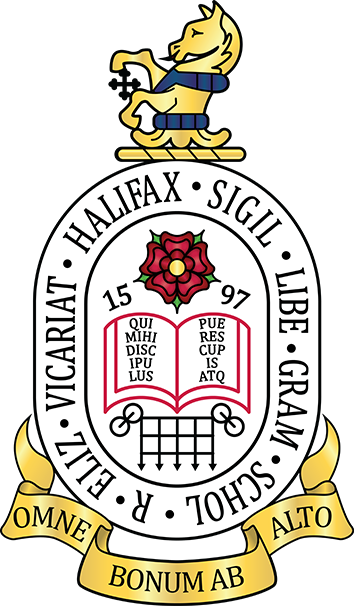
Chemistry is a deep and complex subject; thus our curriculum has been designed in a spiral manner with clear purpose, providing students with many opportunities to revisit learning at regular intervals throughout the different year groups aiding the memorising of facts, chemical formulae and all other aspects of this truly fascinating subject.
Throughout years 7 to 13, we teach students how to think logically and scientifically, how to plan and carry out investigations, and how to make careful observations and interpret experimental results. Chemistry develops logical thinking and the ability to question, analyse and solve problems. Collaborative learning is commonplace in the laboratory; students are regularly given the responsibility to work in groups in order to conduct practical experiments, to carry out research projects, and to discuss and share their findings.
This subject is challenging, but students at Crossley Heath revel in the opportunities to explore, investigate and arrive at their own conclusions helping to develop self-belief and high aspirations. Practical tasks underpin many of the schemes of learning studied as part of the GCSE and A-level examination courses and therefore, a fundamental part of this subject requires a strong appreciation for safe working practices. As such, we expect a high level of respect – for the health and safety of one another (students and staff), the equipment, apparatus, and chemicals.
Chemistry is a very popular subject at A-Level and many of our students go on to study science-based subjects at university. The transferable skills and practices that are developed in Chemistry will also be useful in other scientific subjects such as Biology, Physics, Mathematics, Earth Sciences and Environmental Sciences.
Chemistry at Key Stage 3 and 4
| Term 1 | Term 2 | |
|---|---|---|
| Year 7 | Working Scientifically | Atoms, Elements and Compounds |
| This introduction topic provides students with the knowledge needed to plan, carry, analyse and evaluate practical work in Science. | Building on from Particles, this topic explains the difference between atoms, elements and compounds and introduces the Periodic Table. | |
| Particles | ||
| Particles is a fundamental Chemistry topic in which students learn about the particle model of solids, liquids and gases and how this explains the key properties of substance. | ||
| Year 8 | Periodic Table | Metals and Acids |
| Students look at the Periodic Table in more detail and discovery why the elements are in a certain group. They then study some of the groups on the Periodic Table particularly needed at GCSE and carry out some experiments and shown demonstrations of their reactions | Students look at the reactions of metals with oxygen and acids and use these to discover the reactivity series. Students then further develop these ideas by carrying out displacement reactions. The topic then continues to study other uses of metals such as alloys and compare these to composite materials and polymers. | |
| Separation Techniques | ||
| In this topics, students find out how the composition of a mixture allows different techniques to be used for separation. They study filtration, distillation and chromatography as examples of separation techniques. | ||
| Year 9 | Each of the following topics are our transition module – ‘mixtures’ | Each of the following topics are our transition module – ‘mixtures’ |
| Fundamental Ideas | Bonding and Formulae | |
| Students revisit the key terms atoms, compounds, molecules and mixtures from Year 7 and study how to separate these mixtures in more detail | In bonding and formulae, student learning is extended to atomic structure, covalent, ionic and metallic bonding. Students learn how to write ionic formulae and balance equations, essential skills for chemistry. | |
| Basic Organic Chemistry (Carbon compounds as fuels and feedstocks) | Reactivity of metals | |
| Students are introduced to organic chemistry. During this topic, they learn about crude oil and the important separation technique ‘fractional distillation’. Students are introduced to the homologous series the hydrocarbons and asked to evaluate what the world would be like with less crude oil | During this topic, students look at the reactivity series and how this links to ways of extracting metals from ores. Students recap knowledge of displacement reactions for Year 8 | |
| Chemistry of the Atmosphere | Reactions of Acids | |
| Students study the products of combustion of hydrocarbons and other atmospheric pollutants. Students revisit global warming and the greenhouse effect and evaluate the human impact on this | Students recap knowledge of neutralisation reactions and the pH scale from Year 7. Students then carry out practicals to make salts and discover how to write balanced symbol equations for these reactions. Students are introduced to the idea of strong and weak acids | |
| Earth’s resources and Using Earth’s resources | ||
| In this topic, students look at water treatment in the UK, lifecycle assessments and recycling. Students then study the process of rusting, alloys, composites, ceramics and polymers as uses of the resources we get from Earth | ||
| Year 10 | Quantitative Chemistry 1 | Rates of Reaction |
| In this mathematic topic, students study a variety of different calculations used in the chemical industry. Students learn how to calculate an Mr, % composition, reacting masses, atom economy and % yield. | Students carry out a number of experiments to study the collision theory and how factors such as temperature, concentration, surface area and adding a catalyst can affect the speed of a reaction. Students learn a range of experimental techniques that can be used to follow the progress of a reaction | |
| Structure and Properties | Electrolysis | |
| Structure and Properties develop student understanding from the bonding and formulae topic in Year 9. Students look at how bonding affects the properties of different substances and are introduced in giant covalent structures. Students also look at the developing world of nanoscience. | During electrolysis, students learn how the process of electrolysis works and how to predict the products. Students discover the complication of water and how to write half equations at each electrode. Students look at the specific example of extracting aluminium using this process. | |
| Year 11 | Quantitative Chemistry 2 | Cells, batteries and fuel cells |
| Students complete the remaining calculations from the GCSE specification after having a retrieval opportunity to practice the methods learnt in Year 10. Students carry out gas volume and concentration calculations as well as revisiting strong and weak acids and the pH scale. Students complete the titration required practical to identify the unknown concentration of an acid or an alkali and complete the associated calculation | Students discover how cells and batteries can be made and how the reactivity of metals can affect the voltage produced. Students then look at modern fuel cells and how these can be used as an alternative | |
| Equilibria | Polymer Chemistry | |
| Students study equilibrium and look at the factors that affect the general position of equilibrium. Students then study the Haber Process as a specific example and look at the compromise conditions that are used in this industrial process. Students then study fertilisers as one of the uses of ammonia obtained from the Haber Process. | Students recap addition polymerisation from Year 10 then study condensation polymerisation, natural polymers and DNA as different structures made through polymerisation |


